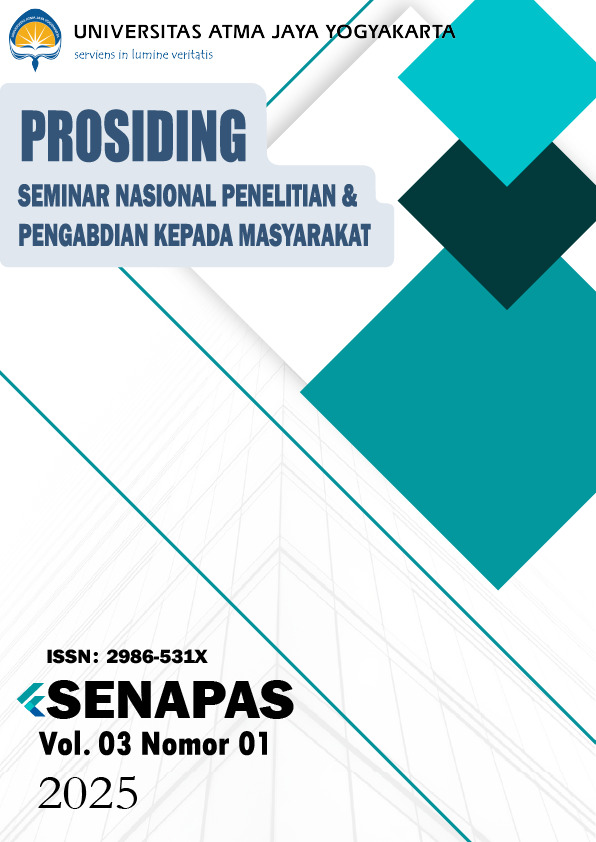Iterative prompting sebagai model pengembangan aplikasi keuangan koperasi berbasis AI
DOI:
https://doi.org/10.24002/senapas.v3i1.12603Keywords:
Black Box Testing, GPT-4, Large Language Models, MySQL, Visual Studio CodeAbstract
Perkembangan Artificial Intelligence (AI), khususnya Large Language Models membuka peluang baru dalam pengembangan perangkat lunak, termasuk di sektor pembuatan aplikasi keuangan. Namun, penggunaan AI untuk menghasilkan kode seringkali terkendala error, inkonsistensi, dan malfungsi akibat instruksi yang kurang jelas. Penelitian ini bertujuan menguji efektivitas iterative prompting dalam menghasilkan kode yang lebih akurat, terutama untuk aplikasi keuangan koperasi. Metode yang digunakan adalah studi literatur, pembuatan kode dengan GPT-4, dan pengujian fungsional menggunakan metode Black Box Testing. Serangkaian prompt terstruktur dirancang untuk membangun fitur aplikasi secara bertahap, kemudian diimplementasikan menggunakan Visual Studio Code dan diintegrasikan dengan basis data MySQL. Hasil pengujian menunjukkan bahwa iterative prompting mampu meningkatkan keberhasilan fungsi aplikasi dan memperbaiki keteraturan kode dibanding menggunakan lazy prompting. Kesimpulannya, prompt engineering yang terencana menjadi kunci pemanfaatan AI secara optimal, khususnya bagi organisasi dengan keterbatasan sumber daya teknologi.
References
[1] C. Liu et al., “Guiding ChatGPT for Better Code Generation: An Empirical Study,” Proc. - 2024 IEEE Int. Conf. Softw. Anal. Evol. Reengineering, SANER 2024, pp. 102–113, 2024, doi: 10.1109/SANER60148.2024.00018.
[2] J. Wei et al., “Chain-of-Thought Prompting Elicits Reasoning in Large Language Models,” Adv. Neural Inf. Process. Syst., vol. 35, no. NeurIPS, pp. 1–43, 2022.
[3] Y. Fu et al., “Security Weaknesses of Copilot-Generated Code in GitHub Projects: An Empirical Study,” ACM Trans. Softw. Eng. Methodol., vol. 1, no. 1, 2025, doi: 10.1145/3716848.
[4] C. Negri-Ribalta, R. Geraud-Stewart, A. Sergeeva, and G. Lenzini, “A systematic literature review on the impact of AI models on the security of code generation,” Front. Big Data, vol. 7, 2024, doi: 10.3389/fdata.2024.1386720.
[5] X. Hou et al., “Large Language Models for Software Engineering: A Systematic Literature Review,” ACM Trans. Softw. Eng. Methodol., vol. 33, no. 8, pp. 1–79, 2024, doi: 10.1145/3695988.
[6] E. G. Santana et al., “Which Prompting Technique Should I Use? An Empirical Investigation of Prompting Techniques for Software Engineering Tasks,” 2025, [Online]. Available: http://arxiv.org/abs/2506.05614
[7] Z. Shao, Y. Gong, Y. Shen, M. Huang, N. Duan, and W. Chen, “Synthetic Prompting: Generating Chain-of-Thought Demonstrations for Large Language Models,” Proc. Mach. Learn. Res., vol. 202, pp. 30706–30775, 2023.
[8] T. Wu, M. Terry, and C. J. Cai, AI Chains: Transparent and Controllable Human-AI Interaction by Chaining Large Language Model Prompts, vol. 1, no. 1. Association for Computing Machinery, 2022. doi: 10.1145/3491102.3517582.
[9] S. Krishna, C. Agarwal, and H. Lakkaraju, “Understanding the Effects of Iterative Prompting on Truthfulness,” Proc. Mach. Learn. Res., vol. 235, pp. 25583–25602, 2024.
[10] B. Reeves et al., “Evaluating the Performance of Code Generation Models for Solving Parsons Problems with Small Prompt Variations,” Annu. Conf. Innov. Technol. Comput. Sci. Educ. ITiCSE, vol. 1, pp. 299–305, 2023, doi: 10.1145/3587102.3588805.
[11] C. Treude and M.-A. Storey, “Generative AI and Empirical Software Engineering: A Paradigm Shift,” 2025.
[12] A. Nurdany and A. C. Prajasari, “Digitalization in Indonesian Cooperatives: Is It Necessary?,” J. Dev. Econ., vol. 5, no. 2, p. 125, 2020, doi: 10.20473/jde.v5i2.19447.
[13] D. R. Indriastuti, R. Susanti, R. Wulandari, and J. Intan, “Building public trust in cooperatives through digitalization,” J. Manag. Digit. Bus., vol. 5, no. 1, pp. 69–84, 2025, doi: 10.53088/jmdb.v5i1.1410.
[14] S. Shukla and H. Joshi, “Security degradation in iterative AI code generation: A systematic analysis of the paradox,” 2025, [Online]. Available: https://arxiv.org/abs/2506.11022
[15] A. Aggarwal, P. Kr. Lohia, N. Seema, K. Dey, and D. Saha, “Black box fairness testing of machine learning models,” Proc. 2019 27th ACM Jt. Meet. Eur. Softw. Eng. Conf. Symp. Found. Softw. Eng., 2019, doi: https://doi.org/10.1145/3338906.3338937.
[16] Team, “Black Box Testing Adalah: Teknik Dan Contoh Pengujiannya.” [Online]. Available: https://codingstudio.id/blog/black-box-testing-adalah/
[17] K. Meinke, “Automated black-box testing of functional correctness using function approximation,” vol. 9, no. 4, 2004, doi: 10.1145/1013886.1007532.
Downloads
Published
Issue
Section
License
Copyright (c) 2025 Vincenzhea Chrissa Siwy, Stephani Inggrit Swastini, Ridwan Sanjaya, Andre Kurniawan Pamudji

This work is licensed under a Creative Commons Attribution-ShareAlike 4.0 International License.









